Production Output Performance in Singapore
VerifiedAdded on 2023/01/13
|10
|2755
|27
AI Summary
This article discusses the production output performance in Singapore and its impact on the economy. It explores the trends witnessed in this sector and the government measures taken to ensure growth. The article also provides insights into the labor market analysis, unemployment types, and government measures to control unemployment. Additionally, it discusses the price level analysis, inflation causes, and government measures to control inflation. Overall, it provides a comprehensive overview of the production output performance in Singapore.
Contribute Materials
Your contribution can guide someone’s learning journey. Share your
documents today.

TABLE OF CONTENTS
Introduction....................................................................................................................................1
Production Output Performance - Singapore.............................................................................1
Production Output Performance – Witnessed trends explanation...............................................3
Production Output Performance –Government Measures...........................................................4
Labor Market Analysis - Singapore.............................................................................................4
Unemployment types in Singapore..............................................................................................5
Unemployment –Government Measures.....................................................................................6
Price Level Analysis - Singapore..................................................................................................6
Inflation Analysis – Causes.........................................................................................................7
Inflation control – Government Measures...................................................................................8
Conclusion......................................................................................................................................8
Reference........................................................................................................................................9
Introduction....................................................................................................................................1
Production Output Performance - Singapore.............................................................................1
Production Output Performance – Witnessed trends explanation...............................................3
Production Output Performance –Government Measures...........................................................4
Labor Market Analysis - Singapore.............................................................................................4
Unemployment types in Singapore..............................................................................................5
Unemployment –Government Measures.....................................................................................6
Price Level Analysis - Singapore..................................................................................................6
Inflation Analysis – Causes.........................................................................................................7
Inflation control – Government Measures...................................................................................8
Conclusion......................................................................................................................................8
Reference........................................................................................................................................9
Secure Best Marks with AI Grader
Need help grading? Try our AI Grader for instant feedback on your assignments.
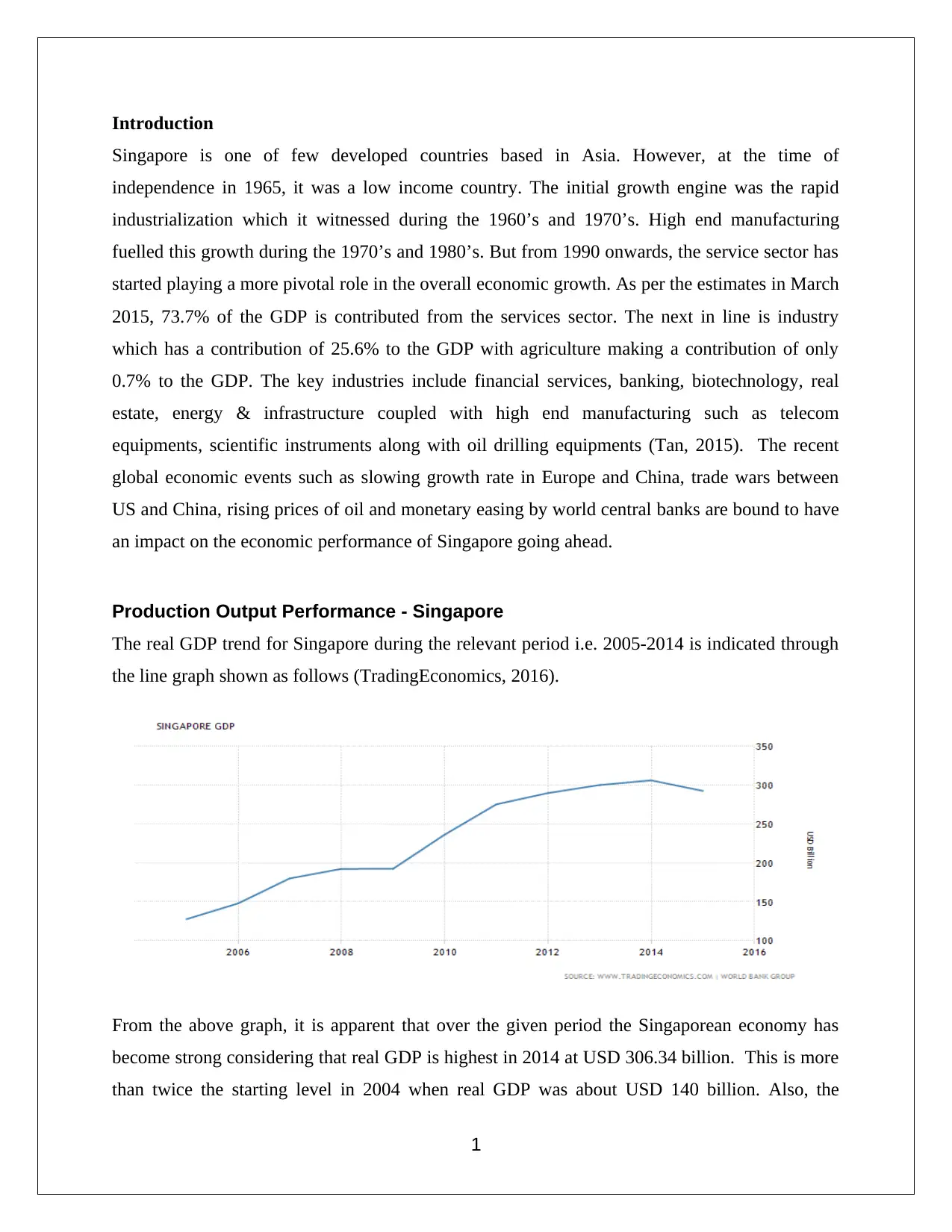
Introduction
Singapore is one of few developed countries based in Asia. However, at the time of
independence in 1965, it was a low income country. The initial growth engine was the rapid
industrialization which it witnessed during the 1960’s and 1970’s. High end manufacturing
fuelled this growth during the 1970’s and 1980’s. But from 1990 onwards, the service sector has
started playing a more pivotal role in the overall economic growth. As per the estimates in March
2015, 73.7% of the GDP is contributed from the services sector. The next in line is industry
which has a contribution of 25.6% to the GDP with agriculture making a contribution of only
0.7% to the GDP. The key industries include financial services, banking, biotechnology, real
estate, energy & infrastructure coupled with high end manufacturing such as telecom
equipments, scientific instruments along with oil drilling equipments (Tan, 2015). The recent
global economic events such as slowing growth rate in Europe and China, trade wars between
US and China, rising prices of oil and monetary easing by world central banks are bound to have
an impact on the economic performance of Singapore going ahead.
Production Output Performance - Singapore
The real GDP trend for Singapore during the relevant period i.e. 2005-2014 is indicated through
the line graph shown as follows (TradingEconomics, 2016).
From the above graph, it is apparent that over the given period the Singaporean economy has
become strong considering that real GDP is highest in 2014 at USD 306.34 billion. This is more
than twice the starting level in 2004 when real GDP was about USD 140 billion. Also, the
1
Singapore is one of few developed countries based in Asia. However, at the time of
independence in 1965, it was a low income country. The initial growth engine was the rapid
industrialization which it witnessed during the 1960’s and 1970’s. High end manufacturing
fuelled this growth during the 1970’s and 1980’s. But from 1990 onwards, the service sector has
started playing a more pivotal role in the overall economic growth. As per the estimates in March
2015, 73.7% of the GDP is contributed from the services sector. The next in line is industry
which has a contribution of 25.6% to the GDP with agriculture making a contribution of only
0.7% to the GDP. The key industries include financial services, banking, biotechnology, real
estate, energy & infrastructure coupled with high end manufacturing such as telecom
equipments, scientific instruments along with oil drilling equipments (Tan, 2015). The recent
global economic events such as slowing growth rate in Europe and China, trade wars between
US and China, rising prices of oil and monetary easing by world central banks are bound to have
an impact on the economic performance of Singapore going ahead.
Production Output Performance - Singapore
The real GDP trend for Singapore during the relevant period i.e. 2005-2014 is indicated through
the line graph shown as follows (TradingEconomics, 2016).
From the above graph, it is apparent that over the given period the Singaporean economy has
become strong considering that real GDP is highest in 2014 at USD 306.34 billion. This is more
than twice the starting level in 2004 when real GDP was about USD 140 billion. Also, the
1
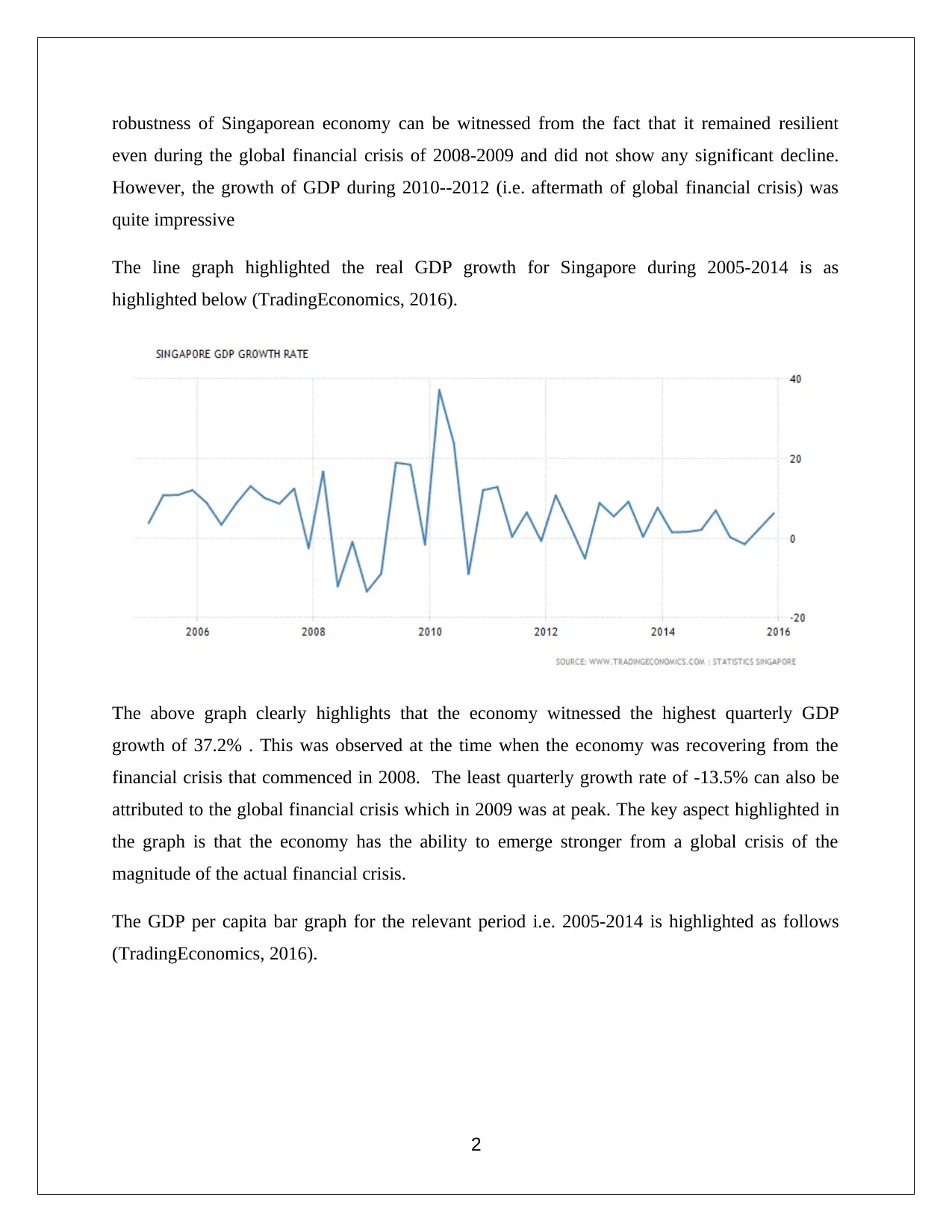
robustness of Singaporean economy can be witnessed from the fact that it remained resilient
even during the global financial crisis of 2008-2009 and did not show any significant decline.
However, the growth of GDP during 2010--2012 (i.e. aftermath of global financial crisis) was
quite impressive
The line graph highlighted the real GDP growth for Singapore during 2005-2014 is as
highlighted below (TradingEconomics, 2016).
The above graph clearly highlights that the economy witnessed the highest quarterly GDP
growth of 37.2% . This was observed at the time when the economy was recovering from the
financial crisis that commenced in 2008. The least quarterly growth rate of -13.5% can also be
attributed to the global financial crisis which in 2009 was at peak. The key aspect highlighted in
the graph is that the economy has the ability to emerge stronger from a global crisis of the
magnitude of the actual financial crisis.
The GDP per capita bar graph for the relevant period i.e. 2005-2014 is highlighted as follows
(TradingEconomics, 2016).
2
even during the global financial crisis of 2008-2009 and did not show any significant decline.
However, the growth of GDP during 2010--2012 (i.e. aftermath of global financial crisis) was
quite impressive
The line graph highlighted the real GDP growth for Singapore during 2005-2014 is as
highlighted below (TradingEconomics, 2016).
The above graph clearly highlights that the economy witnessed the highest quarterly GDP
growth of 37.2% . This was observed at the time when the economy was recovering from the
financial crisis that commenced in 2008. The least quarterly growth rate of -13.5% can also be
attributed to the global financial crisis which in 2009 was at peak. The key aspect highlighted in
the graph is that the economy has the ability to emerge stronger from a global crisis of the
magnitude of the actual financial crisis.
The GDP per capita bar graph for the relevant period i.e. 2005-2014 is highlighted as follows
(TradingEconomics, 2016).
2
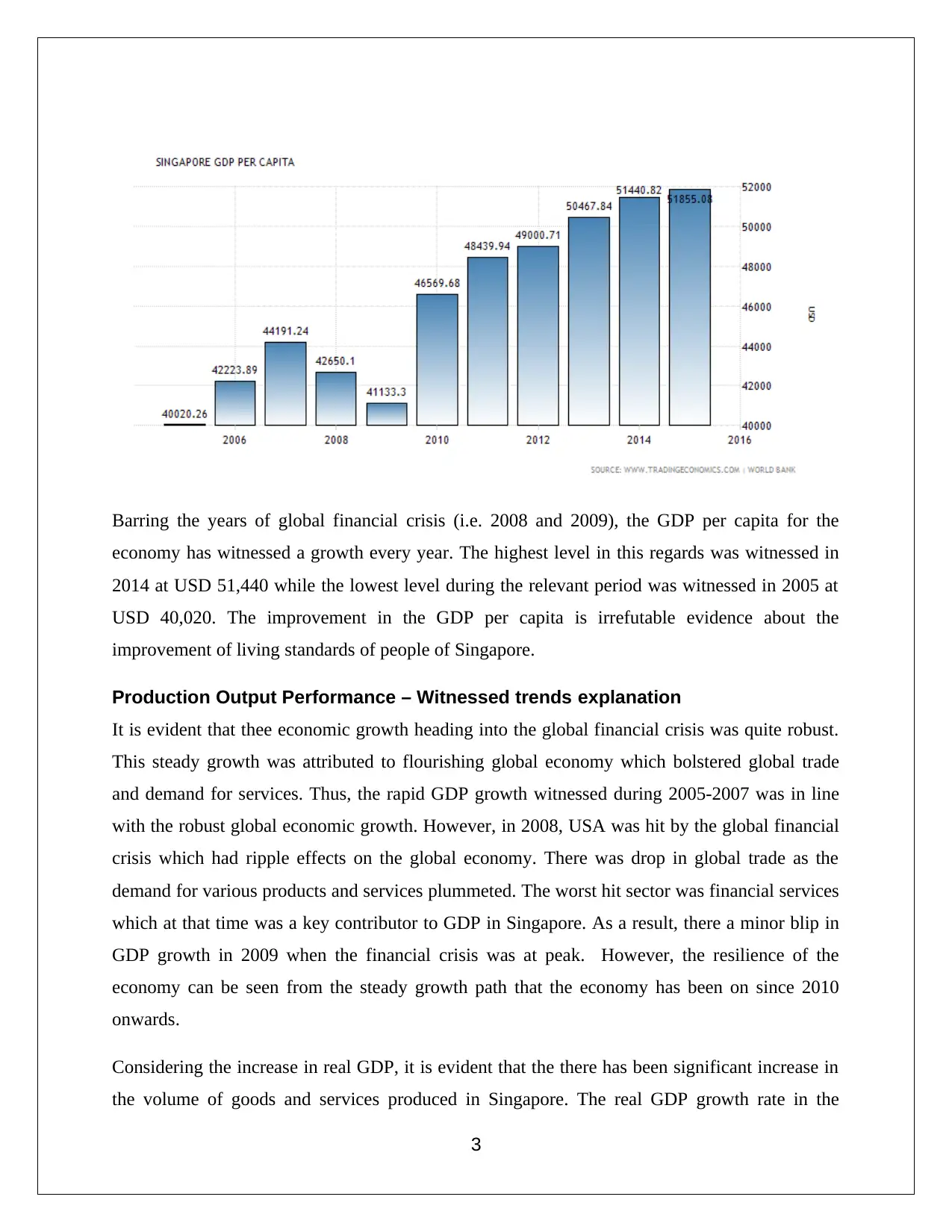
Barring the years of global financial crisis (i.e. 2008 and 2009), the GDP per capita for the
economy has witnessed a growth every year. The highest level in this regards was witnessed in
2014 at USD 51,440 while the lowest level during the relevant period was witnessed in 2005 at
USD 40,020. The improvement in the GDP per capita is irrefutable evidence about the
improvement of living standards of people of Singapore.
Production Output Performance – Witnessed trends explanation
It is evident that thee economic growth heading into the global financial crisis was quite robust.
This steady growth was attributed to flourishing global economy which bolstered global trade
and demand for services. Thus, the rapid GDP growth witnessed during 2005-2007 was in line
with the robust global economic growth. However, in 2008, USA was hit by the global financial
crisis which had ripple effects on the global economy. There was drop in global trade as the
demand for various products and services plummeted. The worst hit sector was financial services
which at that time was a key contributor to GDP in Singapore. As a result, there a minor blip in
GDP growth in 2009 when the financial crisis was at peak. However, the resilience of the
economy can be seen from the steady growth path that the economy has been on since 2010
onwards.
Considering the increase in real GDP, it is evident that the there has been significant increase in
the volume of goods and services produced in Singapore. The real GDP growth rate in the
3
economy has witnessed a growth every year. The highest level in this regards was witnessed in
2014 at USD 51,440 while the lowest level during the relevant period was witnessed in 2005 at
USD 40,020. The improvement in the GDP per capita is irrefutable evidence about the
improvement of living standards of people of Singapore.
Production Output Performance – Witnessed trends explanation
It is evident that thee economic growth heading into the global financial crisis was quite robust.
This steady growth was attributed to flourishing global economy which bolstered global trade
and demand for services. Thus, the rapid GDP growth witnessed during 2005-2007 was in line
with the robust global economic growth. However, in 2008, USA was hit by the global financial
crisis which had ripple effects on the global economy. There was drop in global trade as the
demand for various products and services plummeted. The worst hit sector was financial services
which at that time was a key contributor to GDP in Singapore. As a result, there a minor blip in
GDP growth in 2009 when the financial crisis was at peak. However, the resilience of the
economy can be seen from the steady growth path that the economy has been on since 2010
onwards.
Considering the increase in real GDP, it is evident that the there has been significant increase in
the volume of goods and services produced in Singapore. The real GDP growth rate in the
3
Secure Best Marks with AI Grader
Need help grading? Try our AI Grader for instant feedback on your assignments.
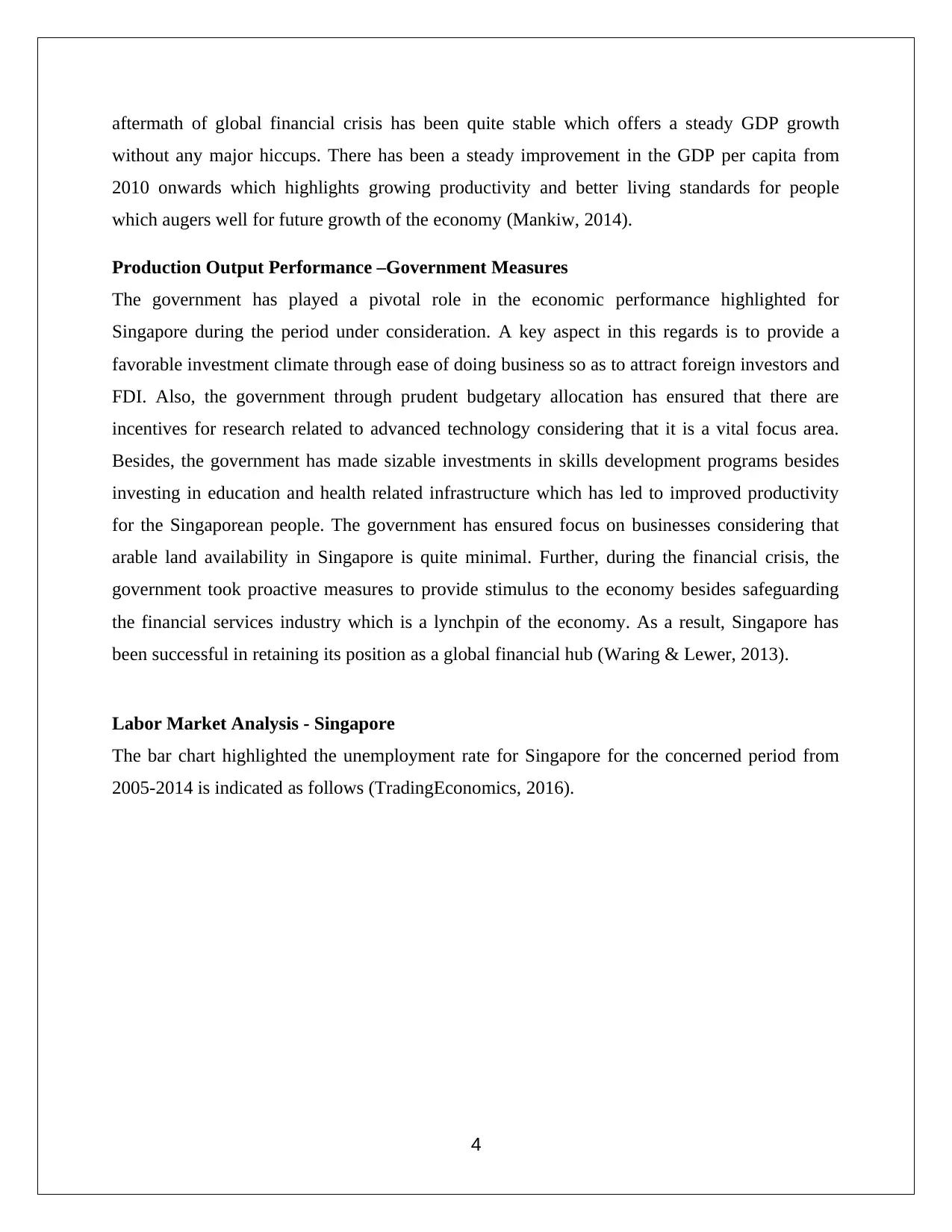
aftermath of global financial crisis has been quite stable which offers a steady GDP growth
without any major hiccups. There has been a steady improvement in the GDP per capita from
2010 onwards which highlights growing productivity and better living standards for people
which augers well for future growth of the economy (Mankiw, 2014).
Production Output Performance –Government Measures
The government has played a pivotal role in the economic performance highlighted for
Singapore during the period under consideration. A key aspect in this regards is to provide a
favorable investment climate through ease of doing business so as to attract foreign investors and
FDI. Also, the government through prudent budgetary allocation has ensured that there are
incentives for research related to advanced technology considering that it is a vital focus area.
Besides, the government has made sizable investments in skills development programs besides
investing in education and health related infrastructure which has led to improved productivity
for the Singaporean people. The government has ensured focus on businesses considering that
arable land availability in Singapore is quite minimal. Further, during the financial crisis, the
government took proactive measures to provide stimulus to the economy besides safeguarding
the financial services industry which is a lynchpin of the economy. As a result, Singapore has
been successful in retaining its position as a global financial hub (Waring & Lewer, 2013).
Labor Market Analysis - Singapore
The bar chart highlighted the unemployment rate for Singapore for the concerned period from
2005-2014 is indicated as follows (TradingEconomics, 2016).
4
without any major hiccups. There has been a steady improvement in the GDP per capita from
2010 onwards which highlights growing productivity and better living standards for people
which augers well for future growth of the economy (Mankiw, 2014).
Production Output Performance –Government Measures
The government has played a pivotal role in the economic performance highlighted for
Singapore during the period under consideration. A key aspect in this regards is to provide a
favorable investment climate through ease of doing business so as to attract foreign investors and
FDI. Also, the government through prudent budgetary allocation has ensured that there are
incentives for research related to advanced technology considering that it is a vital focus area.
Besides, the government has made sizable investments in skills development programs besides
investing in education and health related infrastructure which has led to improved productivity
for the Singaporean people. The government has ensured focus on businesses considering that
arable land availability in Singapore is quite minimal. Further, during the financial crisis, the
government took proactive measures to provide stimulus to the economy besides safeguarding
the financial services industry which is a lynchpin of the economy. As a result, Singapore has
been successful in retaining its position as a global financial hub (Waring & Lewer, 2013).
Labor Market Analysis - Singapore
The bar chart highlighted the unemployment rate for Singapore for the concerned period from
2005-2014 is indicated as follows (TradingEconomics, 2016).
4
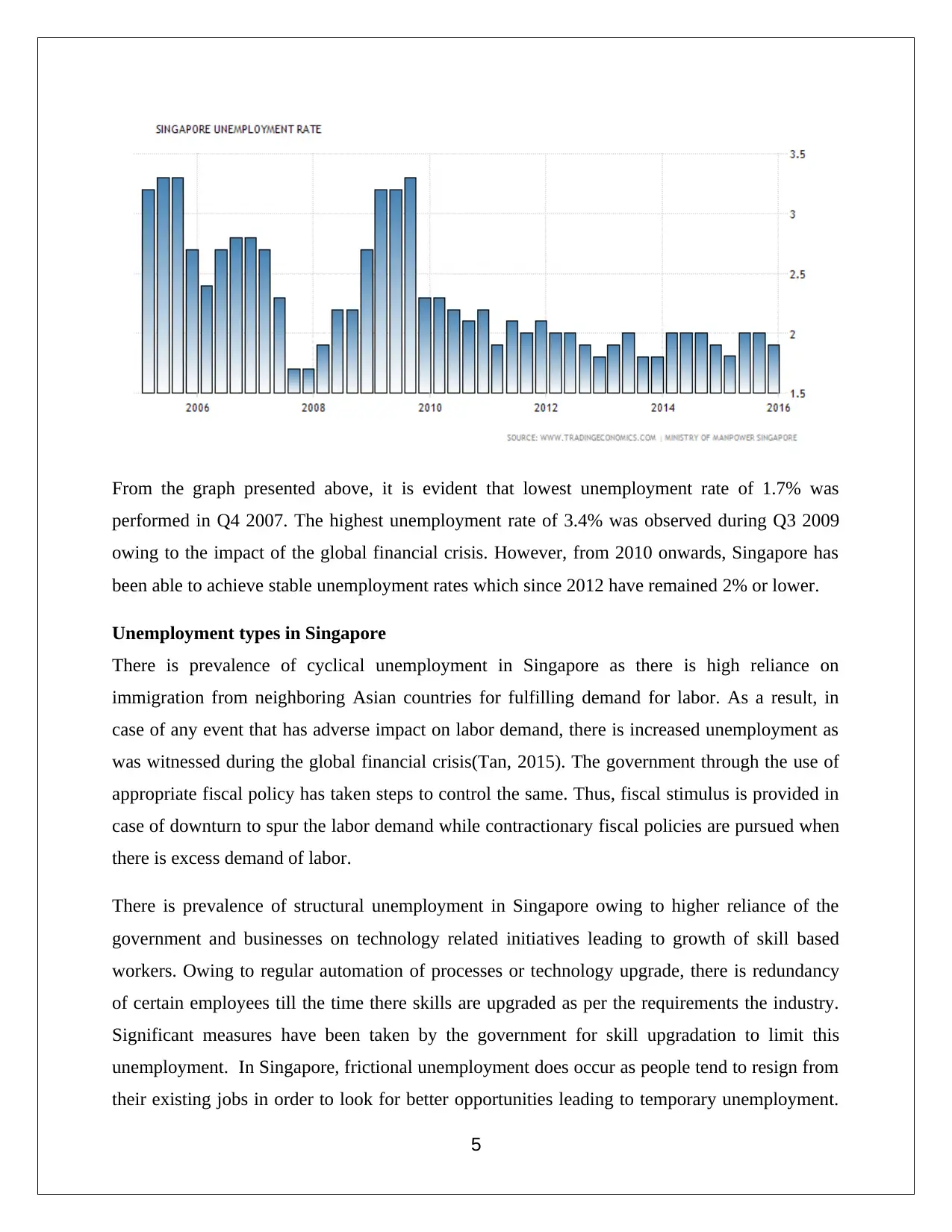
From the graph presented above, it is evident that lowest unemployment rate of 1.7% was
performed in Q4 2007. The highest unemployment rate of 3.4% was observed during Q3 2009
owing to the impact of the global financial crisis. However, from 2010 onwards, Singapore has
been able to achieve stable unemployment rates which since 2012 have remained 2% or lower.
Unemployment types in Singapore
There is prevalence of cyclical unemployment in Singapore as there is high reliance on
immigration from neighboring Asian countries for fulfilling demand for labor. As a result, in
case of any event that has adverse impact on labor demand, there is increased unemployment as
was witnessed during the global financial crisis(Tan, 2015). The government through the use of
appropriate fiscal policy has taken steps to control the same. Thus, fiscal stimulus is provided in
case of downturn to spur the labor demand while contractionary fiscal policies are pursued when
there is excess demand of labor.
There is prevalence of structural unemployment in Singapore owing to higher reliance of the
government and businesses on technology related initiatives leading to growth of skill based
workers. Owing to regular automation of processes or technology upgrade, there is redundancy
of certain employees till the time there skills are upgraded as per the requirements the industry.
Significant measures have been taken by the government for skill upgradation to limit this
unemployment. In Singapore, frictional unemployment does occur as people tend to resign from
their existing jobs in order to look for better opportunities leading to temporary unemployment.
5
performed in Q4 2007. The highest unemployment rate of 3.4% was observed during Q3 2009
owing to the impact of the global financial crisis. However, from 2010 onwards, Singapore has
been able to achieve stable unemployment rates which since 2012 have remained 2% or lower.
Unemployment types in Singapore
There is prevalence of cyclical unemployment in Singapore as there is high reliance on
immigration from neighboring Asian countries for fulfilling demand for labor. As a result, in
case of any event that has adverse impact on labor demand, there is increased unemployment as
was witnessed during the global financial crisis(Tan, 2015). The government through the use of
appropriate fiscal policy has taken steps to control the same. Thus, fiscal stimulus is provided in
case of downturn to spur the labor demand while contractionary fiscal policies are pursued when
there is excess demand of labor.
There is prevalence of structural unemployment in Singapore owing to higher reliance of the
government and businesses on technology related initiatives leading to growth of skill based
workers. Owing to regular automation of processes or technology upgrade, there is redundancy
of certain employees till the time there skills are upgraded as per the requirements the industry.
Significant measures have been taken by the government for skill upgradation to limit this
unemployment. In Singapore, frictional unemployment does occur as people tend to resign from
their existing jobs in order to look for better opportunities leading to temporary unemployment.
5
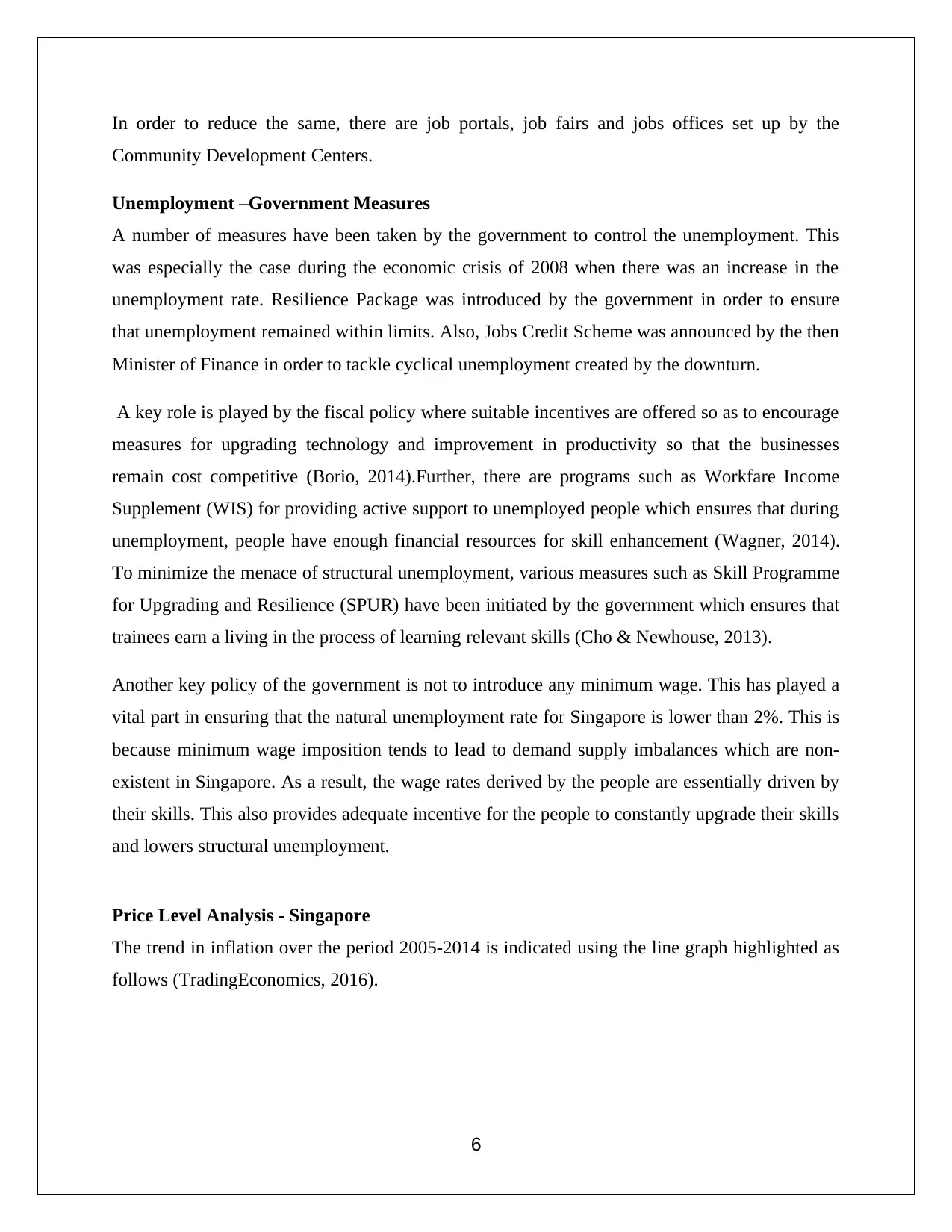
In order to reduce the same, there are job portals, job fairs and jobs offices set up by the
Community Development Centers.
Unemployment –Government Measures
A number of measures have been taken by the government to control the unemployment. This
was especially the case during the economic crisis of 2008 when there was an increase in the
unemployment rate. Resilience Package was introduced by the government in order to ensure
that unemployment remained within limits. Also, Jobs Credit Scheme was announced by the then
Minister of Finance in order to tackle cyclical unemployment created by the downturn.
A key role is played by the fiscal policy where suitable incentives are offered so as to encourage
measures for upgrading technology and improvement in productivity so that the businesses
remain cost competitive (Borio, 2014).Further, there are programs such as Workfare Income
Supplement (WIS) for providing active support to unemployed people which ensures that during
unemployment, people have enough financial resources for skill enhancement (Wagner, 2014).
To minimize the menace of structural unemployment, various measures such as Skill Programme
for Upgrading and Resilience (SPUR) have been initiated by the government which ensures that
trainees earn a living in the process of learning relevant skills (Cho & Newhouse, 2013).
Another key policy of the government is not to introduce any minimum wage. This has played a
vital part in ensuring that the natural unemployment rate for Singapore is lower than 2%. This is
because minimum wage imposition tends to lead to demand supply imbalances which are non-
existent in Singapore. As a result, the wage rates derived by the people are essentially driven by
their skills. This also provides adequate incentive for the people to constantly upgrade their skills
and lowers structural unemployment.
Price Level Analysis - Singapore
The trend in inflation over the period 2005-2014 is indicated using the line graph highlighted as
follows (TradingEconomics, 2016).
6
Community Development Centers.
Unemployment –Government Measures
A number of measures have been taken by the government to control the unemployment. This
was especially the case during the economic crisis of 2008 when there was an increase in the
unemployment rate. Resilience Package was introduced by the government in order to ensure
that unemployment remained within limits. Also, Jobs Credit Scheme was announced by the then
Minister of Finance in order to tackle cyclical unemployment created by the downturn.
A key role is played by the fiscal policy where suitable incentives are offered so as to encourage
measures for upgrading technology and improvement in productivity so that the businesses
remain cost competitive (Borio, 2014).Further, there are programs such as Workfare Income
Supplement (WIS) for providing active support to unemployed people which ensures that during
unemployment, people have enough financial resources for skill enhancement (Wagner, 2014).
To minimize the menace of structural unemployment, various measures such as Skill Programme
for Upgrading and Resilience (SPUR) have been initiated by the government which ensures that
trainees earn a living in the process of learning relevant skills (Cho & Newhouse, 2013).
Another key policy of the government is not to introduce any minimum wage. This has played a
vital part in ensuring that the natural unemployment rate for Singapore is lower than 2%. This is
because minimum wage imposition tends to lead to demand supply imbalances which are non-
existent in Singapore. As a result, the wage rates derived by the people are essentially driven by
their skills. This also provides adequate incentive for the people to constantly upgrade their skills
and lowers structural unemployment.
Price Level Analysis - Singapore
The trend in inflation over the period 2005-2014 is indicated using the line graph highlighted as
follows (TradingEconomics, 2016).
6
Paraphrase This Document
Need a fresh take? Get an instant paraphrase of this document with our AI Paraphraser
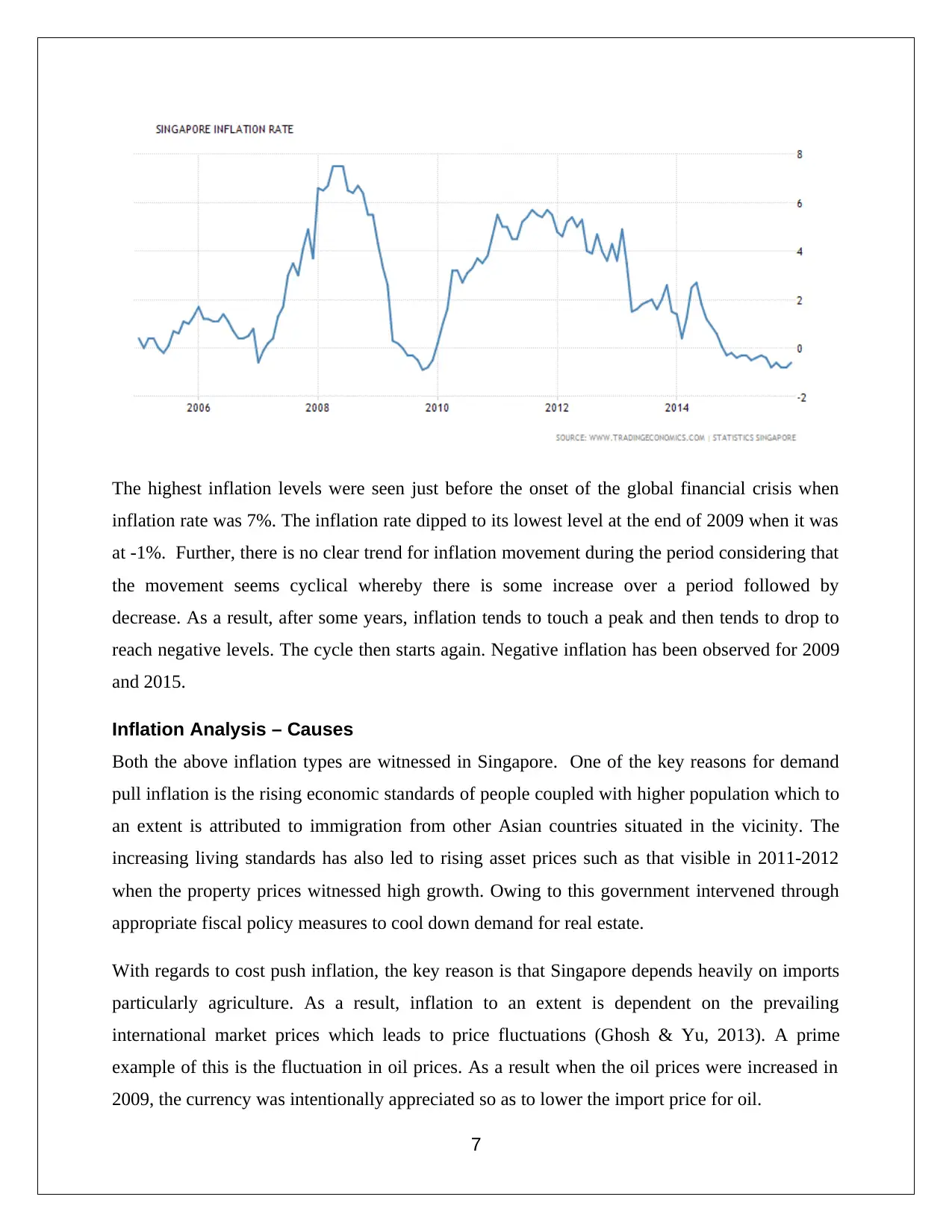
The highest inflation levels were seen just before the onset of the global financial crisis when
inflation rate was 7%. The inflation rate dipped to its lowest level at the end of 2009 when it was
at -1%. Further, there is no clear trend for inflation movement during the period considering that
the movement seems cyclical whereby there is some increase over a period followed by
decrease. As a result, after some years, inflation tends to touch a peak and then tends to drop to
reach negative levels. The cycle then starts again. Negative inflation has been observed for 2009
and 2015.
Inflation Analysis – Causes
Both the above inflation types are witnessed in Singapore. One of the key reasons for demand
pull inflation is the rising economic standards of people coupled with higher population which to
an extent is attributed to immigration from other Asian countries situated in the vicinity. The
increasing living standards has also led to rising asset prices such as that visible in 2011-2012
when the property prices witnessed high growth. Owing to this government intervened through
appropriate fiscal policy measures to cool down demand for real estate.
With regards to cost push inflation, the key reason is that Singapore depends heavily on imports
particularly agriculture. As a result, inflation to an extent is dependent on the prevailing
international market prices which leads to price fluctuations (Ghosh & Yu, 2013). A prime
example of this is the fluctuation in oil prices. As a result when the oil prices were increased in
2009, the currency was intentionally appreciated so as to lower the import price for oil.
7
inflation rate was 7%. The inflation rate dipped to its lowest level at the end of 2009 when it was
at -1%. Further, there is no clear trend for inflation movement during the period considering that
the movement seems cyclical whereby there is some increase over a period followed by
decrease. As a result, after some years, inflation tends to touch a peak and then tends to drop to
reach negative levels. The cycle then starts again. Negative inflation has been observed for 2009
and 2015.
Inflation Analysis – Causes
Both the above inflation types are witnessed in Singapore. One of the key reasons for demand
pull inflation is the rising economic standards of people coupled with higher population which to
an extent is attributed to immigration from other Asian countries situated in the vicinity. The
increasing living standards has also led to rising asset prices such as that visible in 2011-2012
when the property prices witnessed high growth. Owing to this government intervened through
appropriate fiscal policy measures to cool down demand for real estate.
With regards to cost push inflation, the key reason is that Singapore depends heavily on imports
particularly agriculture. As a result, inflation to an extent is dependent on the prevailing
international market prices which leads to price fluctuations (Ghosh & Yu, 2013). A prime
example of this is the fluctuation in oil prices. As a result when the oil prices were increased in
2009, the currency was intentionally appreciated so as to lower the import price for oil.
7
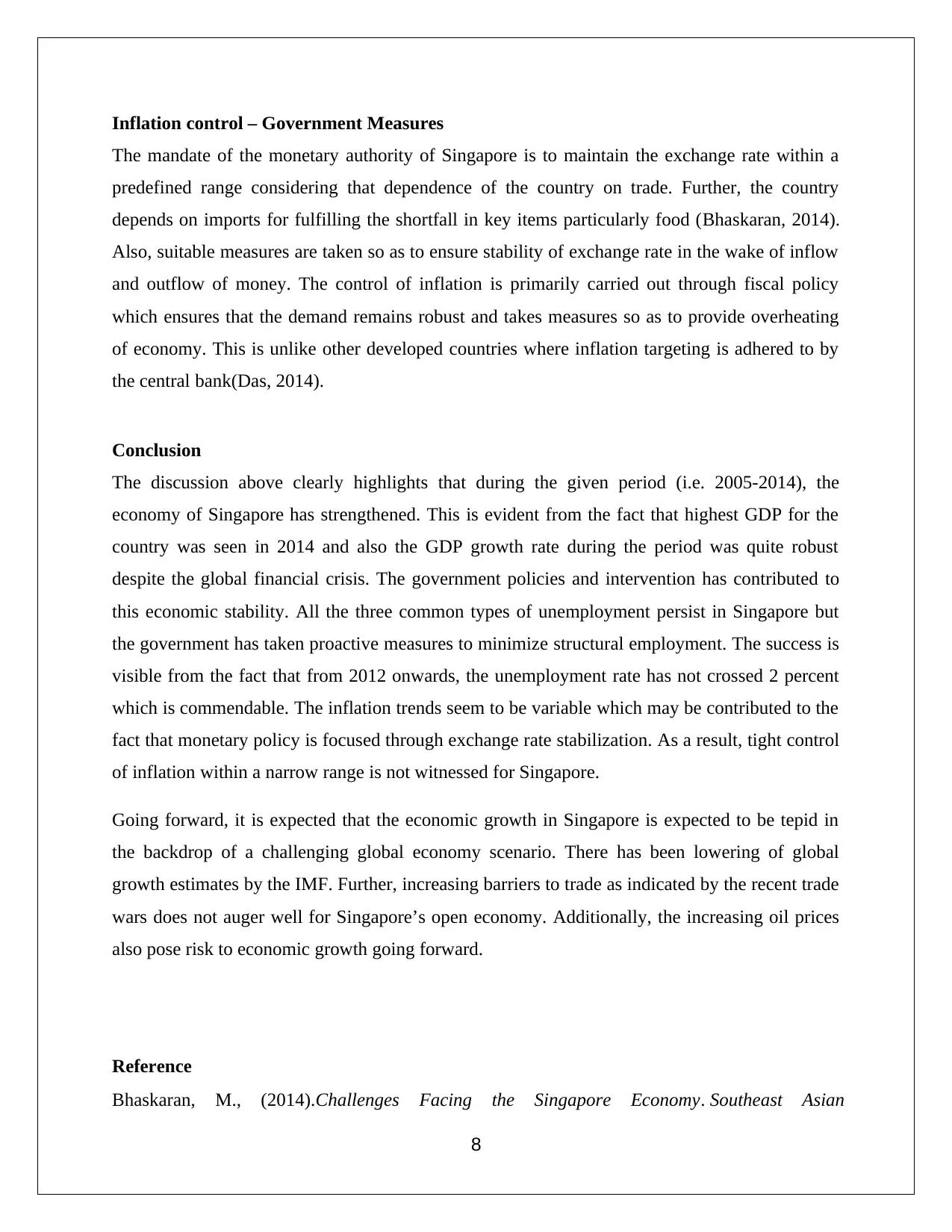
Inflation control – Government Measures
The mandate of the monetary authority of Singapore is to maintain the exchange rate within a
predefined range considering that dependence of the country on trade. Further, the country
depends on imports for fulfilling the shortfall in key items particularly food (Bhaskaran, 2014).
Also, suitable measures are taken so as to ensure stability of exchange rate in the wake of inflow
and outflow of money. The control of inflation is primarily carried out through fiscal policy
which ensures that the demand remains robust and takes measures so as to provide overheating
of economy. This is unlike other developed countries where inflation targeting is adhered to by
the central bank(Das, 2014).
Conclusion
The discussion above clearly highlights that during the given period (i.e. 2005-2014), the
economy of Singapore has strengthened. This is evident from the fact that highest GDP for the
country was seen in 2014 and also the GDP growth rate during the period was quite robust
despite the global financial crisis. The government policies and intervention has contributed to
this economic stability. All the three common types of unemployment persist in Singapore but
the government has taken proactive measures to minimize structural employment. The success is
visible from the fact that from 2012 onwards, the unemployment rate has not crossed 2 percent
which is commendable. The inflation trends seem to be variable which may be contributed to the
fact that monetary policy is focused through exchange rate stabilization. As a result, tight control
of inflation within a narrow range is not witnessed for Singapore.
Going forward, it is expected that the economic growth in Singapore is expected to be tepid in
the backdrop of a challenging global economy scenario. There has been lowering of global
growth estimates by the IMF. Further, increasing barriers to trade as indicated by the recent trade
wars does not auger well for Singapore’s open economy. Additionally, the increasing oil prices
also pose risk to economic growth going forward.
Reference
Bhaskaran, M., (2014).Challenges Facing the Singapore Economy. Southeast Asian
8
The mandate of the monetary authority of Singapore is to maintain the exchange rate within a
predefined range considering that dependence of the country on trade. Further, the country
depends on imports for fulfilling the shortfall in key items particularly food (Bhaskaran, 2014).
Also, suitable measures are taken so as to ensure stability of exchange rate in the wake of inflow
and outflow of money. The control of inflation is primarily carried out through fiscal policy
which ensures that the demand remains robust and takes measures so as to provide overheating
of economy. This is unlike other developed countries where inflation targeting is adhered to by
the central bank(Das, 2014).
Conclusion
The discussion above clearly highlights that during the given period (i.e. 2005-2014), the
economy of Singapore has strengthened. This is evident from the fact that highest GDP for the
country was seen in 2014 and also the GDP growth rate during the period was quite robust
despite the global financial crisis. The government policies and intervention has contributed to
this economic stability. All the three common types of unemployment persist in Singapore but
the government has taken proactive measures to minimize structural employment. The success is
visible from the fact that from 2012 onwards, the unemployment rate has not crossed 2 percent
which is commendable. The inflation trends seem to be variable which may be contributed to the
fact that monetary policy is focused through exchange rate stabilization. As a result, tight control
of inflation within a narrow range is not witnessed for Singapore.
Going forward, it is expected that the economic growth in Singapore is expected to be tepid in
the backdrop of a challenging global economy scenario. There has been lowering of global
growth estimates by the IMF. Further, increasing barriers to trade as indicated by the recent trade
wars does not auger well for Singapore’s open economy. Additionally, the increasing oil prices
also pose risk to economic growth going forward.
Reference
Bhaskaran, M., (2014).Challenges Facing the Singapore Economy. Southeast Asian
8
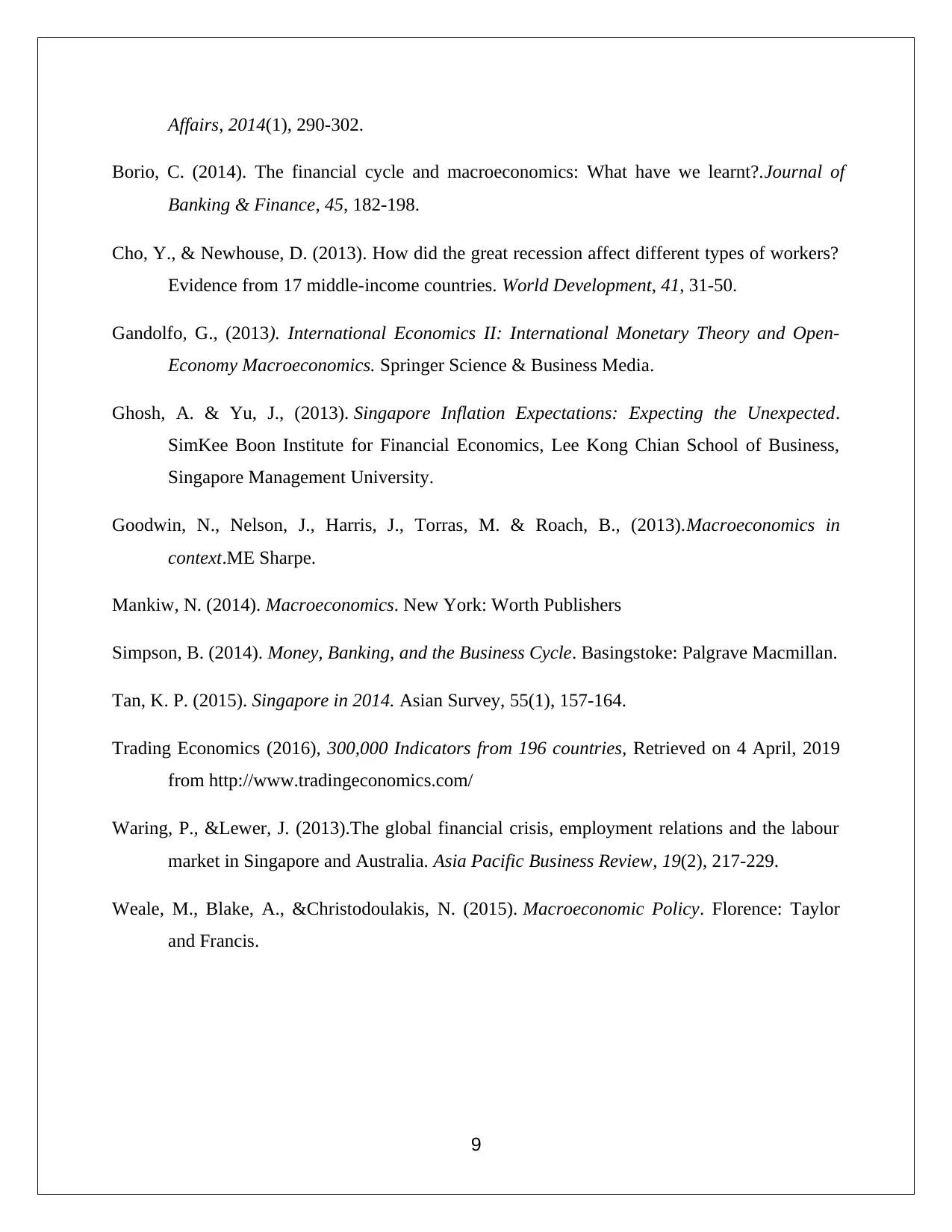
Affairs, 2014(1), 290-302.
Borio, C. (2014). The financial cycle and macroeconomics: What have we learnt?.Journal of
Banking & Finance, 45, 182-198.
Cho, Y., & Newhouse, D. (2013). How did the great recession affect different types of workers?
Evidence from 17 middle-income countries. World Development, 41, 31-50.
Gandolfo, G., (2013). International Economics II: International Monetary Theory and Open-
Economy Macroeconomics. Springer Science & Business Media.
Ghosh, A. & Yu, J., (2013). Singapore Inflation Expectations: Expecting the Unexpected.
SimKee Boon Institute for Financial Economics, Lee Kong Chian School of Business,
Singapore Management University.
Goodwin, N., Nelson, J., Harris, J., Torras, M. & Roach, B., (2013).Macroeconomics in
context.ME Sharpe.
Mankiw, N. (2014). Macroeconomics. New York: Worth Publishers
Simpson, B. (2014). Money, Banking, and the Business Cycle. Basingstoke: Palgrave Macmillan.
Tan, K. P. (2015). Singapore in 2014. Asian Survey, 55(1), 157-164.
Trading Economics (2016), 300,000 Indicators from 196 countries, Retrieved on 4 April, 2019
from http://www.tradingeconomics.com/
Waring, P., &Lewer, J. (2013).The global financial crisis, employment relations and the labour
market in Singapore and Australia. Asia Pacific Business Review, 19(2), 217-229.
Weale, M., Blake, A., &Christodoulakis, N. (2015). Macroeconomic Policy. Florence: Taylor
and Francis.
9
Borio, C. (2014). The financial cycle and macroeconomics: What have we learnt?.Journal of
Banking & Finance, 45, 182-198.
Cho, Y., & Newhouse, D. (2013). How did the great recession affect different types of workers?
Evidence from 17 middle-income countries. World Development, 41, 31-50.
Gandolfo, G., (2013). International Economics II: International Monetary Theory and Open-
Economy Macroeconomics. Springer Science & Business Media.
Ghosh, A. & Yu, J., (2013). Singapore Inflation Expectations: Expecting the Unexpected.
SimKee Boon Institute for Financial Economics, Lee Kong Chian School of Business,
Singapore Management University.
Goodwin, N., Nelson, J., Harris, J., Torras, M. & Roach, B., (2013).Macroeconomics in
context.ME Sharpe.
Mankiw, N. (2014). Macroeconomics. New York: Worth Publishers
Simpson, B. (2014). Money, Banking, and the Business Cycle. Basingstoke: Palgrave Macmillan.
Tan, K. P. (2015). Singapore in 2014. Asian Survey, 55(1), 157-164.
Trading Economics (2016), 300,000 Indicators from 196 countries, Retrieved on 4 April, 2019
from http://www.tradingeconomics.com/
Waring, P., &Lewer, J. (2013).The global financial crisis, employment relations and the labour
market in Singapore and Australia. Asia Pacific Business Review, 19(2), 217-229.
Weale, M., Blake, A., &Christodoulakis, N. (2015). Macroeconomic Policy. Florence: Taylor
and Francis.
9
1 out of 10
Related Documents
Your All-in-One AI-Powered Toolkit for Academic Success.
+13062052269
info@desklib.com
Available 24*7 on WhatsApp / Email
![[object Object]](/_next/static/media/star-bottom.7253800d.svg)
Unlock your academic potential
© 2024 | Zucol Services PVT LTD | All rights reserved.



